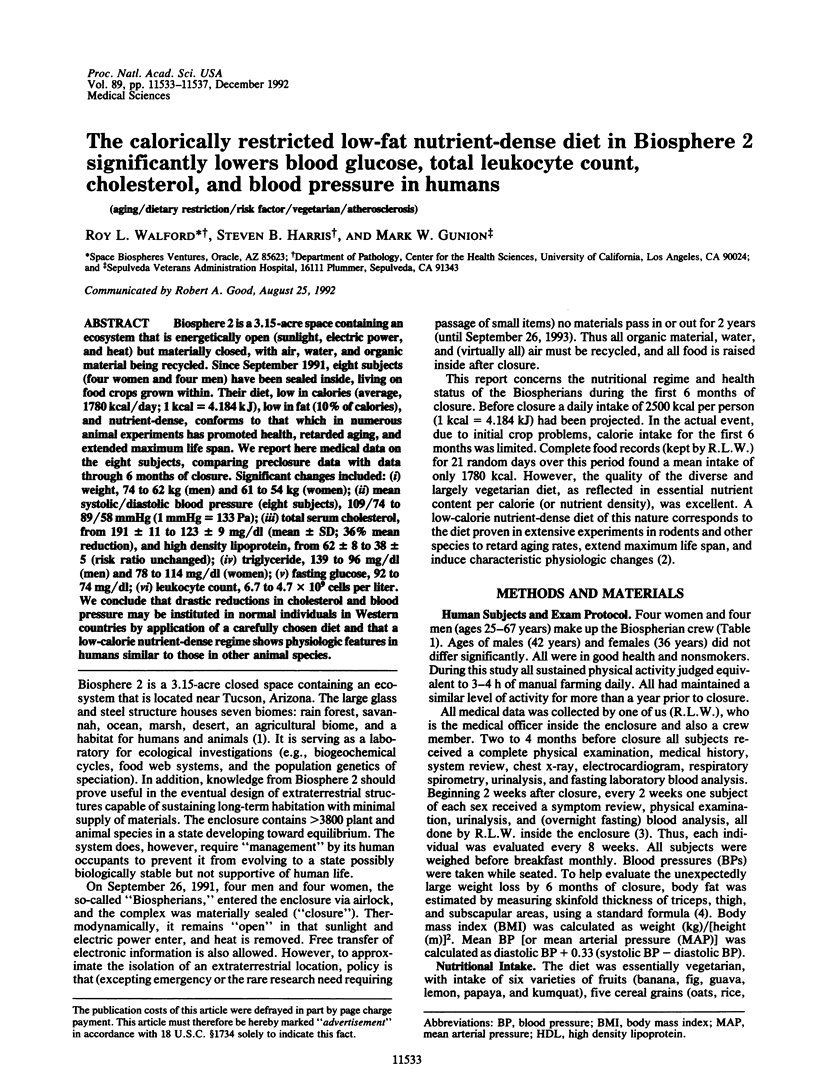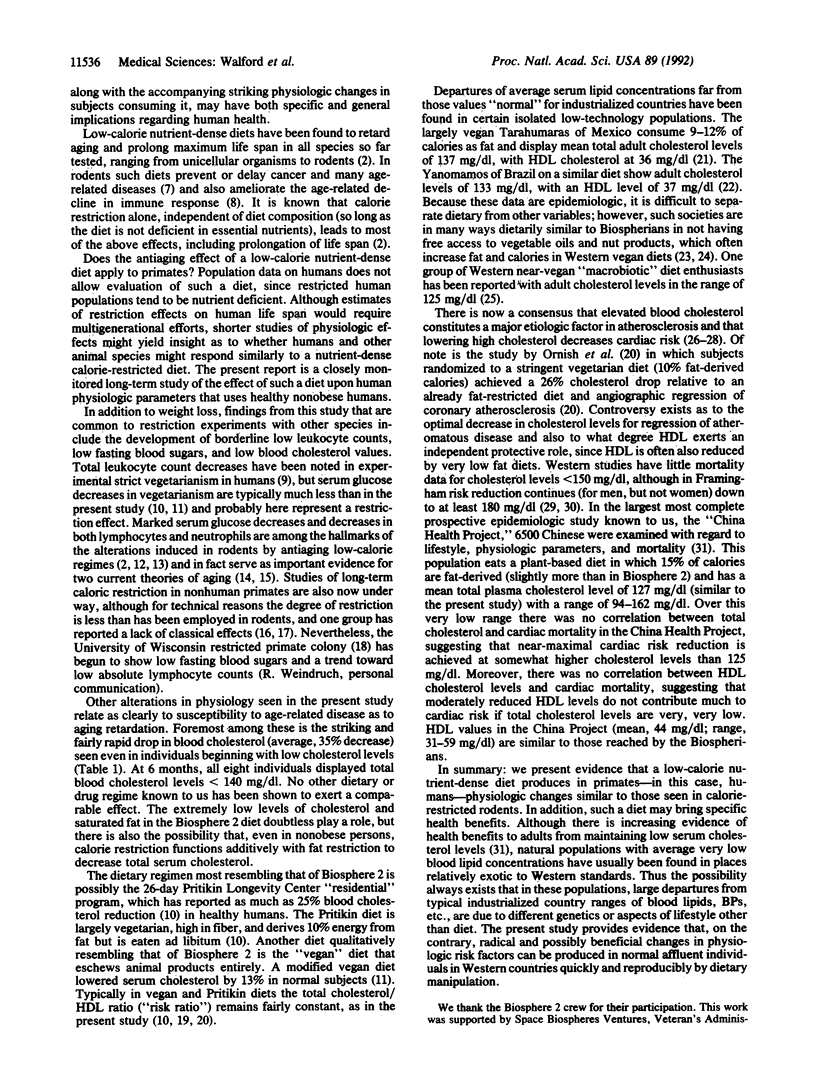Abstract
Biosphere 2 is a 3.15-acre space containing an ecosystem that is energetically open (sunlight, electric power, and heat) but materially closed, with air, water, and organic material being recycled. Since September 1991, eight subjects (four women and four men) have been sealed inside, living on food crops grown within. Their diet, low in calories (average, 1780 kcal/day; 1 kcal = 4.184 kJ), low in fat (10% of calories), and nutrient-dense, conforms to that which in numerous animal experiments has promoted health, retarded aging, and extended maximum life span. We report here medical data on the eight subjects, comparing preclosure data with data through 6 months of closure. Significant changes included: (i) weight, 74 to 62 kg (men) and 61 to 54 kg (women); (ii) mean systolic/diastolic blood pressure (eight subjects), 109/74 to 89/58 mmHg (1 mmHg = 133 Pa); (iii) total serum cholesterol, from 191 +/- 11 to 123 +/- 9 mg/dl (mean +/- SD; 36% mean reduction), and high density lipoprotein, from 62 +/- 8 to 38 +/- 5 (risk ratio unchanged); (iv) triglyceride, 139 to 96 mg/dl (men) and 78 to 114 mg/dl (women); (v) fasting glucose, 92 to 74 mg/dl; (vi) leukocyte count, 6.7 to 4.7 x 10(9) cells per liter. We conclude that drastic reductions in cholesterol and blood pressure may be instituted in normal individuals in Western countries by application of a carefully chosen diet and that a low-calorie nutrient-dense regime shows physiologic features in humans similar to those in other animal species.
Full text
PDF




Selected References
These references are in PubMed. This may not be the complete list of references from this article.
- Abdulla M., Andersson I., Asp N. G., Berthelsen K., Birkhed D., Dencker I., Johansson C. G., Jägerstad M., Kolar K., Nair B. M. Nutrient intake and health status of vegans. Chemical analyses of diets using the duplicate portion sampling technique. Am J Clin Nutr. 1981 Nov;34(11):2464–2477. doi: 10.1093/ajcn/34.11.2464. [DOI] [PubMed] [Google Scholar]
- Brownell K. D., Steen S. N., Wilmore J. H. Weight regulation practices in athletes: analysis of metabolic and health effects. Med Sci Sports Exerc. 1987 Dec;19(6):546–556. [PubMed] [Google Scholar]
- Bush T. L., Fried L. P., Barrett-Connor E. Cholesterol, lipoproteins, and coronary heart disease in women. Clin Chem. 1988;34(8B):B60–B70. [PubMed] [Google Scholar]
- Cerami A. Hypothesis. Glucose as a mediator of aging. J Am Geriatr Soc. 1985 Sep;33(9):626–634. doi: 10.1111/j.1532-5415.1985.tb06319.x. [DOI] [PubMed] [Google Scholar]
- Connor W. E., Cerqueira M. T., Connor R. W., Wallace R. B., Malinow M. R., Casdorph H. R. The plasma lipids, lipoproteins, and diet of the Tarahumara indians of Mexico. Am J Clin Nutr. 1978 Jul;31(7):1131–1142. doi: 10.1093/ajcn/31.7.1131. [DOI] [PubMed] [Google Scholar]
- Cooper R. S., Goldberg R. B., Trevisan M., Tsong Y., Liu K., Stamler J., Rubenstein A., Scanu A. M. The selective lipid-lowering effect of vegetarianism on low density lipoproteins in a cross-over experiment. Atherosclerosis. 1982 Sep;44(3):293–305. doi: 10.1016/0021-9150(82)90004-1. [DOI] [PubMed] [Google Scholar]
- Fisher M., Levine P. H., Weiner B., Ockene I. S., Johnson B., Johnson M. H., Natale A. M., Vaudreuil C. H., Hoogasian J. The effect of vegetarian diets on plasma lipid and platelet levels. Arch Intern Med. 1986 Jun;146(6):1193–1197. [PubMed] [Google Scholar]
- Ingram D. K., Cutler R. G., Weindruch R., Renquist D. M., Knapka J. J., April M., Belcher C. T., Clark M. A., Hatcherson C. D., Marriott B. M. Dietary restriction and aging: the initiation of a primate study. J Gerontol. 1990 Sep;45(5):B148–B163. doi: 10.1093/geronj/45.5.b148. [DOI] [PubMed] [Google Scholar]
- Johnson B. C., Gajjar A., Kubo C., Good R. A. Calories versus protein in onset of renal disease in NZB x NZW mice. Proc Natl Acad Sci U S A. 1986 Aug;83(15):5659–5662. doi: 10.1073/pnas.83.15.5659. [DOI] [PMC free article] [PubMed] [Google Scholar]
- Kannel W. B. Cholesterol and risk of coronary heart disease and mortality in men. Clin Chem. 1988;34(8B):B53–B59. [PubMed] [Google Scholar]
- Koizumi A., Masuda H., Wada Y., Tsukada M., Kawamura K., Kamiyama S., Walford R. L. Caloric restriction perturbs the pituitary-ovarian axis and inhibits mouse mammary tumor virus production in a high-spontaneous-mammary-tumor-incidence mouse strain (C3H/SHN). Mech Ageing Dev. 1989 Aug;49(2):93–104. doi: 10.1016/0047-6374(89)90093-6. [DOI] [PubMed] [Google Scholar]
- LaRosa J. C., Hunninghake D., Bush D., Criqui M. H., Getz G. S., Gotto A. M., Jr, Grundy S. M., Rakita L., Robertson R. M., Weisfeldt M. L. The cholesterol facts. A summary of the evidence relating dietary fats, serum cholesterol, and coronary heart disease. A joint statement by the American Heart Association and the National Heart, Lung, and Blood Institute. The Task Force on Cholesterol Issues, American Heart Association. Circulation. 1990 May;81(5):1721–1733. doi: 10.1161/01.cir.81.5.1721. [DOI] [PubMed] [Google Scholar]
- Lindahl O., Lindwall L., Spångberg A., Stenram A., Ockerman P. A. A vegan regimen with reduced medication in the treatment of hypertension. Br J Nutr. 1984 Jul;52(1):11–20. doi: 10.1079/bjn19840066. [DOI] [PubMed] [Google Scholar]
- Mancilha-Carvalho J. J., Crews D. E. Lipid profiles of Yanomamo Indians of Brazil. Prev Med. 1990 Jan;19(1):66–75. doi: 10.1016/0091-7435(90)90009-9. [DOI] [PubMed] [Google Scholar]
- Masoro E. J., Katz M. S., McMahan C. A. Evidence for the glycation hypothesis of aging from the food-restricted rodent model. J Gerontol. 1989 Jan;44(1):B20–B22. doi: 10.1093/geronj/44.1.b20. [DOI] [PubMed] [Google Scholar]
- Ornish D., Brown S. E., Scherwitz L. W., Billings J. H., Armstrong W. T., Ports T. A., McLanahan S. M., Kirkeeide R. L., Brand R. J., Gould K. L. Can lifestyle changes reverse coronary heart disease? The Lifestyle Heart Trial. Lancet. 1990 Jul 21;336(8708):129–133. doi: 10.1016/0140-6736(90)91656-u. [DOI] [PubMed] [Google Scholar]
- Pyörälä K. Preventive cardiology: a progress report. Prev Med. 1990 Jan;19(1):78–96. doi: 10.1016/0091-7435(90)90011-8. [DOI] [PubMed] [Google Scholar]
- Rosenthal M. B., Barnard R. J., Rose D. P., Inkeles S., Hall J., Pritikin N. Effects of a high-complex-carbohydrate, low-fat, low-cholesterol diet on levels of serum lipids and estradiol. Am J Med. 1985 Jan;78(1):23–27. doi: 10.1016/0002-9343(85)90456-5. [DOI] [PubMed] [Google Scholar]
- Sacks F. M., Castelli W. P., Donner A., Kass E. H. Plasma lipids and lipoproteins in vegetarians and controls. N Engl J Med. 1975 May 29;292(22):1148–1151. doi: 10.1056/NEJM197505292922203. [DOI] [PubMed] [Google Scholar]
- Sanders T. A., Key T. J. Blood pressure, plasma renin activity and aldosterone concentrations in vegans and omnivore controls. Hum Nutr Appl Nutr. 1987 Jun;41(3):204–211. [PubMed] [Google Scholar]
- Weindruch R., Gottesman S. R., Walford R. L. Modification of age-related immune decline in mice dietarily restricted from or after midadulthood. Proc Natl Acad Sci U S A. 1982 Feb;79(3):898–902. doi: 10.1073/pnas.79.3.898. [DOI] [PMC free article] [PubMed] [Google Scholar]


